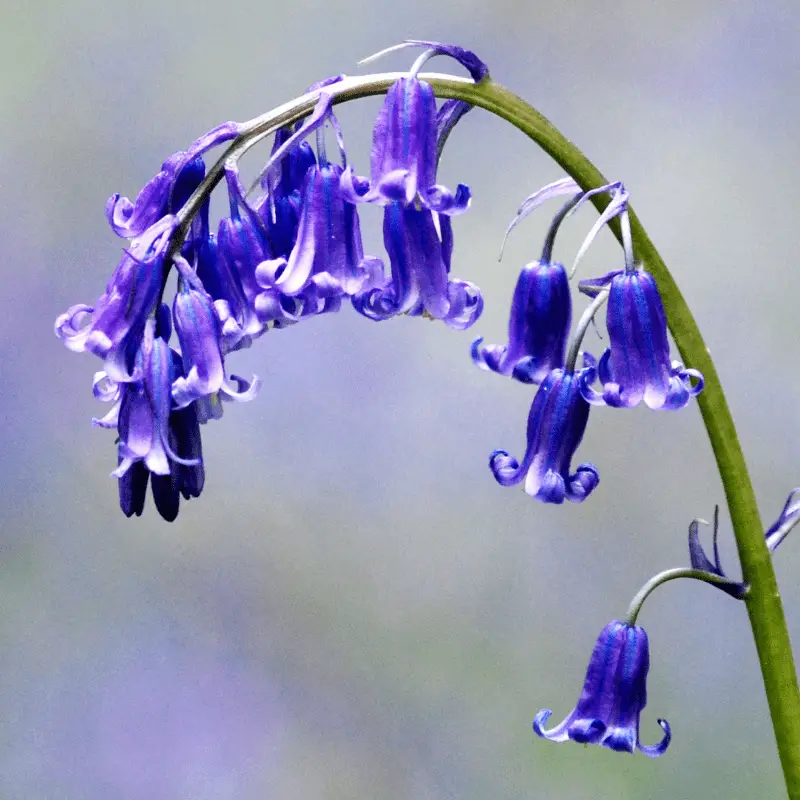Whenever you think of spring, you imagine the colourful flowers outside. The bright blue flowers of bluebells are a sight to behold when they arrive in swathes in parks, woods and gardens. However, if you are a dog owner, you may be unsure about these pretty flowers. After all, we all want the best for our beloved pets.
Common Bluebells Overview
- Origin: UK
- Scientific name: Hyacinthoides non-scripta
- Family: Asparagaceae
- Kingdom: Plantae
- Order: Asparagales
- Subfamily: Scilloideae
Bluebells are poisonous to dogs. All parts of this breathtaking flower create a risk for your dog. If consumed, bluebells can cause an upset stomach in dogs, and if consumed in large portions, bluebells could even be fatal.
Bluebells (How to recognise them)
They are a deep violet-blue colour, and the flowers hang downwards, which are shaped like a bell, hence the name. Inside, the bell you will find creamy white coloured pollen. Other varieties of bluebells can also be pink or white. However, they look the same and will hang off to the side with bell-shaped flowers. They smell incredible sweet.



The UK bluebells are protected under the Wildlife and Countryside Act (1981)
When do bluebells flower?
In the UK, these flowers can flower from mid-April to late May, depending on spring temperature. They couldn’t possibly flower from March if it’s been a warm spring or later in April if it’s been a cold start.
Why are bluebells so poisonous?
Each part of this lovely flower contains a toxic chemical known as glycosides. This chemical is poisonous to dogs. If your dog consumes any of the elements of this plant, it can lead to severe stomach upset. Eben, without your dog consuming this flower, the bluebell sap can lead to skin irritations and dermatitis.
Glycoside
Even though the chemical itself is poisonous to dogs and humans in its natural form, it also plays a vital role in making medicine like antibiotics and cardiac therapy with the correct modification.
Common Plants That contain Glycosides
Glycosides are present in several other plants, not just bluebells. Below is a list of the other common plants
- Common oleander
- Lily of the valley
- Purple foxglove
- Ouabain
- Woodly foxglove
- Yellow oleander
Are all bluebells varieties toxic to dogs?
Yes, all varieties of bluebells are toxic to dogs as they all contain glycosides. Glycosides is a poisonous chemical found in all bluebell varieties and can cause an upset stomach in dogs and can be fatal if your dog has consumed large amounts.
Varieties
- Native Eastern North America Virginia Bluebell
- Native Scotland Harebell
- Native UK Bluebells
- Spanish Bluebells
Should my dog know not to eat bluebells?
Yes, your dog should have an instinct to know not to consume poisonous plants. However, puppies don’t have the same thought process yet, so if you have a puppy, make sure you have a watchful eye over them.

Stop Your Dog from Consuming Bluebells
Even though severe cases of poisoning caused by a dog consuming too many Bluebells are rare, it does occur when spring arrives. During this time, veterinary clinics get a lot of cases of unwell dogs with severely upset stomachs. Fortunately, you can stop your dog from getting unwell after having such an unwise garden snack. The easiest way to do that is to keep an eye on your pet while they are out in the garden. Teach your dog the leave it command. You should be specifically vigilant if your dog loves to dig around. If your dog shows any sign of being unwell after being in the garden or walking, get in touch with your veterinary professional immediately.
Bluebell Poisoning
Some of these symptoms of poisoning in dogs include the following:
- Decrease heart rate
- Depression
- Diarrhoea
- Excessive drooling
- Stomach pain
- Tremor
- Vomiting
If you notice that your pet dog is showing any of these symptoms, get in touch with your veterinarian immediately.
Treatment
The more quickly you react to the symptoms, the faster it will recuperate. You should be extra vigilant if you have a suspect plant within the nibble or paw reach of your dog. Prompt treatment can sometimes save the life of your pet dog and avoid too much discomfort.
Your veterinarian can recommend that you give your puppy a fresh bowl of water or milk to drink in such a situation. Sometimes they can also advise you to induce vomiting. In other cases, they may tell you to take things slow and take a wait-and-see approach. It would be best not to give any treatment to your dog without consulting with your veterinarian first. Understand that providing the wrong antidote to your dog can create a more severe condition.
Other Flowers
Check the below list if they are safe for dogs or not, and understand your dog to make the right decisions before planting any flowers.
Conclusion
Bluebells are toxic to dogs, so when out and about, take extra care with your dogs. Even though adult dogs should know that these are not for eating, some puppies will undoubtedly have a nibble. Always have your puppy on a lead, and if you have any in your garden, perhaps removing them and replanting them elsewhere would be a good decision. Bluebells will never be on sale to the general public due to their protection of them so no need to panic when buying flowers at a market as they shouldn’t be on sale.
Good luck!
